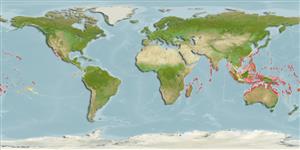>
Ovalentaria/misc (Various families in series Ovalentaria) >
Pomacentridae (Damselfishes) > Microspathodontinae
Etymology: Plectroglyphidodon: Greek,plektron = anything to strike with, spur + Greek, glyphis = carved + Greek, odous = teeth (Ref. 45335).
More on authors: Fowler & Ball.
Environment: milieu / climate zone / depth range / distribution range
Ökologie
seewasser riff-verbunden; standorttreu; tiefenbereich 0 - 30 m (Ref. 128797). Tropical; 30°N - 30°S
Indo-Pacific: East Africa to the Hawaiian, Marquesan, and Pitcairn islands, north to the Ryukyu and Bonin islands, south to Lord Howe Island and Rapa. Unknown from the Red Sea, Persian Gulf and Gulf of Oman (Ref. 11441).
Size / Gewicht / Alter
Maturity: Lm ? range ? - ? cm
Max length : 14.0 cm TL Männchen/unbestimmt; (Ref. 11441)
Rückenflossenstacheln (insgesamt) : 12; Rückenflossenweichstrahlen (insgesamt) : 17 - 19; Afterflossenstacheln: 2; Afterflossenweichstrahlen: 16 - 18.
Adults are found clear water, inner to outer reef crests in rich coral habitat (Ref. 48636). Benthopelagic (Ref. 58302). Common in passages, frequently associated with Acropora, Stylophora, or Pocillopora coral heads or a single head of Pocillopora eydouxi (= Pocillopora grandis). Usually seen solitary (Ref. 48636). Feed on benthic algae and probably coral polyps. Oviparous, distinct pairing during breeding (Ref. 205). Eggs are demersal and adhere to the substrate (Ref. 205). Males guard and aerate the eggs (Ref. 205). Diurnal species (Ref. 13550).
Life cycle and mating behavior
Geschlechtsreife | Fortpflanzung | Ablaichen | Eier | Fecundity | Larven
Oviparous, distinct pairing during breeding (Ref. 205). Eggs are demersal and adhere to the substrate (Ref. 205). Males guard and aerate the eggs (Ref. 205).
Allen, G.R., 1991. Damselfishes of the world. Mergus Publishers, Melle, Germany. 271 p. (Ref. 7247)
IUCN Rote Liste Status (Ref. 130435: Version 2024-2)
Bedrohung für Menschen
Harmless
Nutzung durch Menschen
Fischereien: nicht kommerziell; Aquarium: Kommerziell
Tools
Zusatzinformationen
Download XML
Internet Quellen
Estimates based on models
Preferred temperature (Ref.
123201): 24.7 - 29.2, mean 28.2 °C (based on 2485 cells).
Phylogenetic diversity index (Ref.
82804): PD
50 = 0.5010 [Uniqueness, from 0.5 = low to 2.0 = high].
Bayesian length-weight: a=0.02188 (0.01190 - 0.04023), b=2.95 (2.79 - 3.11), in cm total length, based on LWR estimates for this species & (Sub)family-body (Ref.
93245).
Trophic level (Ref.
69278): 3.4 ±0.6 se; based on diet studies.
Widerstandsfähigkeit (Ref.
120179): hoch, Verdopplung der Population dauert weniger als 15 Monate. (Preliminary K or Fecundity.).
Fishing Vulnerability (Ref.
59153): Low vulnerability (10 of 100).
Nutrients (Ref.
124155): Calcium = 91.4 [46.7, 145.6] mg/100g; Iron = 0.68 [0.40, 1.10] mg/100g; Protein = 18.6 [17.4, 19.7] %; Omega3 = 0.114 [0.069, 0.182] g/100g; Selenium = 21.5 [12.4, 40.0] μg/100g; VitaminA = 92.1 [27.5, 293.1] μg/100g; Zinc = 1.43 [0.97, 2.06] mg/100g (wet weight);
